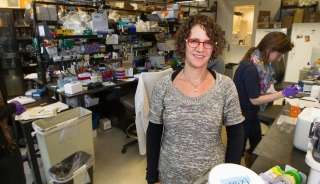An enzyme that fixes broken DNA sometimes destroys it instead

Enzymes inside cells that normally repair damaged DNA sometimes wreck it instead, researchers at the Stanford University School of Medicine have found. The insight could lead to a better understanding of the causes of some types of cancer and neurodegenerative disease.
In a paper to be published online Nov. 27 in Molecular Cell, the researchers explain how the recently discovered mechanism of DNA damage occurs when genetic transcripts, composed of RNA, stick to the DNA instead of detaching from it.
Certain enzymes, called endonucleases, are attracted to DNA/RNA hybrids that form when gene transcription goes awry—and they cut the DNA like scissors to damage it.
The researchers conducted the study with human cells in culture, using molecular biology techniques to turn off specific genes. This allowed them to induce cells to form the hybrids and to see what would happen when various enzymes were inhibited.
"What we found is when we get rid of these endonucleases, we don't see the damage," said Karlene Cimprich, PhD, professor of chemical and systems biology and the paper's senior author. "When those nucleases are present, they cut the DNA in the hybrid."
Both helpful and harmful
What's really interesting, said Cimprich, is these same enzymes are noted for fixing DNA damage. "They take part in the repair of DNA lesions from sunlight and certain chemicals, like those found in cigarette smoke," she said. The structures formed by the hybrid of RNA and DNA are similar to those formed in cells damaged by ultraviolet light.
"What we believe happens is that the repair machinery misrecognizes these structures and cuts them," she said. She and her colleagues have launched more experiments to figure out why this happens.
The study not only opens up new avenues for understanding DNA damage, it expands the role of the messenger RNA molecule. In the last decade, researchers have discovered many new roles for RNA, aside from its long-recognized role in providing instructions for building proteins.
"The messenger RNA is known to transmit the information and make the proteins," said Cimprich. "But we found that if it isn't removed properly it destroys the DNA that originally encoded it."
A study published by Cimprich and colleagues in Molecular Cell in 2009 alerted researchers to the importance of RNA in DNA damage. Their genomewide screen to identify factors that help fix DNA damage found hundreds of different molecules, some of which the researchers expected. But most of the molecules were surprises. And most interacted in some way with RNA, which pointed to RNA as a culprit in causing DNA damage.
"When we thought about what would cause DNA damage in cells, we thought about problems with DNA replication and DNA repair," she said. "But now we're beginning to see that problems with RNA can also feed back to the DNA."
Understanding role of enzymes
Now the researchers are trying to understand why some of the enzymes that control transcription are causing DNA damage, with an eye to understanding the roots of some cancers. "A lot of oncogenes are transcription factors. We're looking at whether those cause genome instability by making hybrids like those we've seen. Is this a different route to DNA damage and cancer?" Cimprich said.
"Recent work has also implicated these hybrids in neurodegenerative diseases, including Fragile X syndrome, Friedreich's ataxia and amyotrophic lateral sclerosis type 4," said Julie Sollier, PhD, the lead author of the paper and a postdoctoral researcher. "We would like to explore the potential role of the endonucleases we identified in these diseases as well."



















